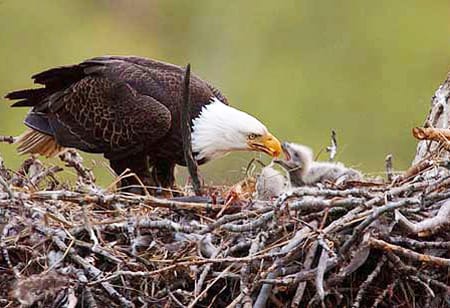

FORSYTH, Ga. –-(Ammoland.com)- Bald eagle populations are soaring in Georgia.
According to preliminary results, Department of Natural Resources aerial surveys in January and March documented 158 occupied nesting territories, 116 successful nests and 190 young fledged. The totals are up from last year’s 142 nesting territories, 111 successful nests and 175 eaglets.
The number of bald eagle nests in Georgia is steadily climbing, underscoring the rebound of our national bird from near-extinction through much of its range 40 years ago. Nests numbered in the single digits in Georgia when survey leader Jim Ozier started searching for them more than two decades ago.
This comeback was powered in part by Georgians who support the Georgia Wildlife Conservation Fund through their state income tax returns. As this year’s tax deadline nears, those who haven’t filed are encouraged to contribute $2 or more to the Wildlife Conservation Fund – line 26 on Form 500 or line 10 on Form 500EZ.
Giving 2 wildlife benefits more than 1,000 Georgia plant and animal species listed as species of conservation concern, including bald eagles, which are continuing to nest in new areas across the state. “They’re now in places I never would have thought they’d show up,” said Ozier, a Nongame Conservation Section program manager with the DNR’s Wildlife Resources Division.
Examples this year include the campus of Berry College near Rome and a rural Piedmont Georgia farm that is not near a major reservoir or river, the usual source of fish, birds and turtles that eagles prey on. Eagle populations in Georgia are concentrated along the coast and around reservoirs and rivers.
One new nest that proved no surprise is on Lake Lanier. Although an eagle nest had not been documented before at the 38,000-acre North Georgia lake, bald eagles have often been seen there.
The number of young eagles fell this year just shy of 2010, when the survey counted 194 eaglets. Ozier said warmer than usual weather might have resulted in eagles nesting and raising their young earlier, with some eaglets fledging before the survey was taken. Yet, fluctuations are also expected.
The public can let Ozier know about any eagle nests they see, reporting them online (www.georgiawildlife.com/node/1322) or by phone (478-994-1438). These reports often lead to nests not monitored before. DNR works with landowners to help protect eagle nests on their property.
Eagle surveys are just part the DNR Nongame Section’s mission to conserve nongame wildlife – native animals not legally hunted or fished for – and native plants and habitats. The section receives no state appropriations for this work. The Wildlife Conservation Fund checkoff, also called Give Wildlife a Chance, provides significant support, accounting for 9 percent of fund revenues in fiscal year 2011.
Georgians can deduct checkoff contributions from refunds or add them to payments. They can also give when filing electronically or through a tax preparer. Go to www.georgiawildlife.com/TaxCheckoff for details. Please consult a tax professional about deducting contributions.
EAGLE SURVEY SNAPSHOT
- ** Occupied nesting territories: 158 (preliminary)
- ** Successful nests: 116
- ** Young fledged: 190
- ** Counties with active nest: 53 (49 in 2011)
- ** Lead counties: Chatham – 17; McIntosh – 11; Liberty and Camden – 10 each; Lowndes – nine; Decatur – eight; Glynn – six
AVM IN FOCUS In Georgia and other states, scientists are researching the impact of Avian Vacuolar Myelinopathy, or AVM, a neurological disease deadly to waterbirds, mainly coots and bald eagles. One suspected link is that coots ingest a strain of cyanobacteria or blue-green algae sometimes found on submerged aquatic plants, particularly hydrilla. A toxin in the algae then sickens eagles that eat contaminated coots.
Discovered in Arkansas in 1995, AVM has been documented in Georgia at lakes Clarks Hill, Juliette, Varner and West Point, and some small reservoirs near Atlanta. Clarks Hill, also known as J. Strom Thurmond Reservoir, is a hotspot. Eagle nesting territories on the lake have dwindled from eight to one, Jim Ozier said.
Scientists are exploring what can be done to combat AVM. A possible approach is using grass carp or herbicides, or both, to manage against the submerged aquatic vegetation that hosts the apparently toxic algae.
The post Bald Eagle Nesting Gains Ground In Georgia appeared first on AmmoLand.com.
